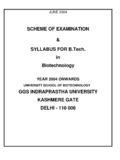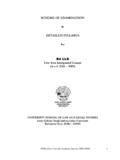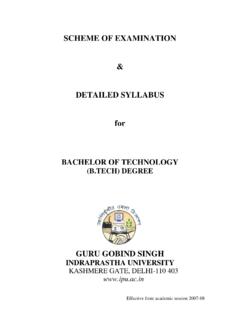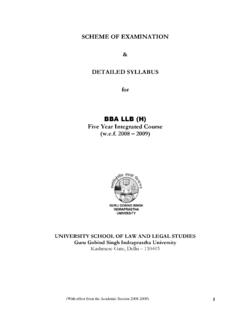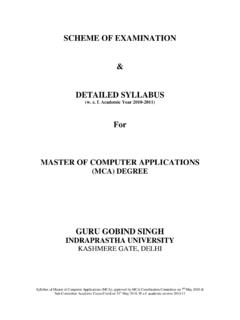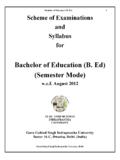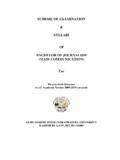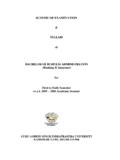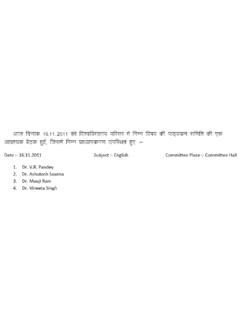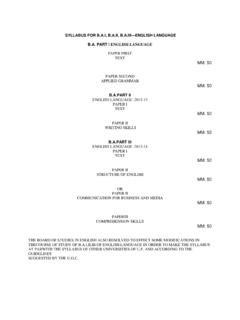Transcription of SCHEME OF EXAMINATION DETAILED SYLLABUS for
1 SCHEME OF EXAMINATION & DETAILED SYLLABUS for BACHELOR OF LAW [ (H)] Five Year Integrated Course ( 2005-2006) GURU GOBIND SIGNH INDRAPRASTHA UNIVERSITY KASHMERE GATE, DELHI FIVE-YEAR LAW COURSE (H) PROGRAMME FIRST YEAR First Semester Code No. SUBJECTS L T / P Credit 101 Legal Method 4 1 5 103 History-I 4 1 5 105 Political Science-I 4 1 5 107 Law of Contract I 4 1 5 109 Economics-I 4 1 5 111 English and Legal Language 2 1 3 Second Semester Code No. SUBJECTS L T / P Credit 102 History II 4 1 5 104 Political Science II 4 1 5 106 Sociology 4 1 5 108 Economics II 4 1 5 110 Law of Contract II 4 1 5 112 Techniques of Communication, Client Interviewing and Counselling 2 1 3 Paper Code: 101 L T Credit Paper: Legal Method 4 1 5 I.
2 Meaning and Classification of Laws a. What is law? b. Meaning and definition c. How is law made? d. What are the uses and functions of law? e. Classification of laws: i. Public and Private Law ii. Substantive and Procedural Law iii. Municipal and International Law (Number of hours - 10) II. Sources of Law a. Custom b. Precedent c. Legislation (Number of hours 09) III. Basic Concepts of Indian Legal System a. Common Law b. Constitution as the Basic Law c. Rule of Law d. Separation of Powers e. Judicial system in India (Number of hours 10) IV. Legal Writing and Research a. Legal materials Case law b.
3 Statutes, Reports, Journals, Manuals, Digests etc. c. Importance of legal research d. Techniques of Legal Research e. Legal writings and citations (Number of hours 10) Text books / Compulsory Readings (Latest editions only): 1. Glanville Willains Learning the law 2. Nomita Aggarwal Jurisprudence (Legal Theory) 3. Tripathi An Introduction to Jurisprudence and Legal theory Further Readings: 1. Benjamin N. Cardozo, The Nature of Judicial Process 2. Publication Indian Legal System 3. ILI Publication in Legal Research and Methodology 1. This paper focuses on orientation of students to legal studies from the point of view of basic concepts of law and legal system.
4 2. Pattern of Question Paper: The question paper shall have Parts A and B . In part A there shall be one compulsory question based on objective or short answer type questions carrying 25 marks and covering the entire course. In part B , two questions of marks each shall be asked from every unit asking the candidates to attempt one question from each unit. Essential Case Law: 1. Raj Kishore Jha v. State of Bihar, AIR 2003 4664 2. Commissioner of Income Tax, Hyderabad v. PJ. Chemicals, 1994 Suppl. (3) 535 3. Air India v. Nargesh Mirza, AIR 1981 SC 1829 4. Geeta Hariharan v. Reserve Bank of India, AIR 1999 1149 5.
5 Neera Mathur v. 1992 (1) 286 6. Basu v. State of , 1997 (1) SCC 417 7. Dwrka Prasad Aggarwal v. Aggarwal, AIR 2003 2686 8. Commissioner of Wealth Tax, Meerut v. Sharvan Kumar Swarup & Sons, 1994 (6) 623 9. Shikhar Chand Falodia Sanganeria, AIR 2004 Gau. 19. 10. Grandphone Company v. Pandey, AIR 1984 667 11. Peoples Union for Civil Liberties v. Union of India 1997 (1) 301 12. Lachman v. Nand Lal, AIR 1914 Oudh. 123 13. Tangkhul v. R. Simirei, AIR 1961 Manipur 1 14. Balusami v. Balkrishna, AIR 1957 Mad. 97 15. Tekaha v. Sakumeeran AIR 2004 3674 16. Superintendent and Remembrancer of Legal Affairs West Bengal v.
6 Corporation of Calcutta AIR 1967 997 17. Nath Bros. Exim. International Ltd. v. Best Roadways Ltd. 2000 (4) 553 18. State of Bihar v. Sonawati AIR 1961 221, 231 19. Samta Vedike v. State of Kar2003 J. 1003 Kar 20. Ram Jawaya Kapur v. State of Punjab, AIR 1955 549, 556 Paper Code: 103 L T Credit Paper: History I 4 1 5 I. Introduction a. History Meaning and Methodology b. Relationship between Law and History (Number of hours 08) II. Polity, State and Administration a. Ancient India Vedic Polity Mauryan State Gupta Polity b. Medieval India Chola Village Administration Delhi Sultanat Mughal State (Mansabdari System and Administrative Apparatus) c.
7 Theory of Kingship and nature of State in Ancient and Medieval India Brahmani Buddhist Kautilyan Balban Alauddin Khilji Turko Afgan - Concept d. Political movements of Gandhi Non-Cooperative Civil Disobedience, and Quit India (Number of hours 10) III. Society and Economy a. Social Institutions Varna Jati Gotra Pravara Family Slavery Position of Woman Changes in Medieval period b. Reformation in Medieval and modern times Nanak Kabir Raja Ram Mohan Roy 1. This paper focuses on broad features of legal institutions and administration in ancient, medieval and modern India. 2. Pattern of Question Paper: The question paper shall have Parts A and B.
8 In part A there shall be one compulsory question based on objective or short answer type questions carrying 25 marks and covering the entire course. In part B , two questions of marks each shall be asked from every unit asking the candidates to attempt one question from each unit Aligarh movement and Backward Caste Movement ( Ambedkar Jotiba Phule and Naicker) Economic Structure Feudalism Post- Maoryan Economy Gupta economy Iqtadari system Agrarian Reforms of Alauddin Khalji and Mohammed-bin Tughlaq Market reforms of Alauddin Khalji Drain of Wealth and Stages of Colonialism (Number of hours 10) IV.
9 Legal Systems and Institutions Ancient India and Medieval India a. Sources: Vedic Texts, Brahmanas, Sutras (Kalpa and Dharma), Dharma Shastra, Asthashastra, custom b. Thinkers Manu, Brihaspati, Yajnavaltya Narada, Katyayan c. Judicial System Types of court: Pratishita, Apratishta, Mudrita, Sasita, Guilds, Panchayats, Kantakasodhana, Dharmasthiyaa Procedures : Appointment of judges, Trail, witness, Pleaders, secret agents, werdeit and punishment, role of judges and investigation d. Sources of Islamic Law : Sharia and Hadis e. Salient features of Islamic Criminal Law f. Judicial organization : King, Chief Qazi, Judicial Officers, Investigative process and punishments g.
10 Law with regard to non-Muslims h. Evolution of judicial setup changes introduced by Akbar (Number of hours 10) Text Books / Compulsory Readings (Latest editions only): 1. Sreeniwasmurthy History (for law students) 2. Habib & Nizami Comprehensive History of India, Vol. V and VI Further Readings: 1. Bipan Chandra India s Struggle for Independence (Pengieon) 2. Jurisprudence 3. Jois Ancient Legal thought 4. Basham Wonder that was India, Part-I 5. Rizvi Wonder that was India, Part II Paper Code: 105 L T Credit Paper: Political Science I 4 1 5 I. Introduction and theories A. Introduction a.
